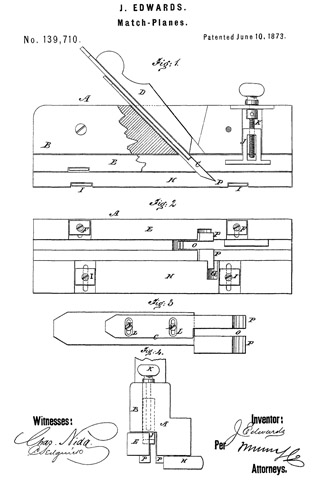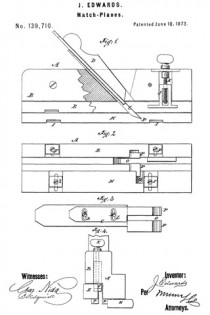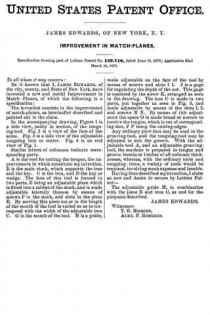No. 139,710 – Improvement In Match-Planes (James Edwards) (1873)

UNITED STATES PATENT OFFICE.
_________________
JAMES EDWARDS, OF NEW YORK, N. Y.
IMPROVEMENT IN MATCH-PLANES.
_________________
Specification forming part of Letters Patent No. 139,710, dated June 10, 1873; application filed March 15, 1873.
_________________
To all whom it may concern:
Be it known that I, JAMES EDWARDS, of the city, county, and State of New York, have invented a new and useful Improvement in Match-Planes, of which the following is a specification:
The invention consists in the irnprovement of match-planes, as hereinafter described and pointed out in the claim.
In the accompanying drawing, Figure 1 is a side view, partly in section, of the tonguing-tool. Fig. 2 is a view of the face of the same. Fig. 3 is a side view of the adjustable tonguing iron or cutter. Fig. 4 is an end view of Fig. 1.
Similar letters of reference indicate corresponding parts.
A is the tool tor cutting the tongue, the improvements in which constitute my invention. B is the main stock, which supports the iron and the key. C is the iron, and D the key or wedge. The face of this tool is formed in two parts, E being an adjustable piece which is fitted into a rabbet of the stock, and is made adjustable laterally thereon by means of screws F in the stock, and slots in the piece E. By moving this piece out or in the length of the mouth of the tool is varied so as to correspond with the width of the adjustable iron C. G is the mouth of the tool. H is a guide, made adjustable on the face of the tool by means of screws and slots I I. J is a gage for regulating the depth of the cut. This gage is operated by the screw K, arranged as seen in the drawing. The iron C is made in two parts, put together as seen in Fig. 3, and made adjustable by means of the slots L L and screws N N. By means of this adjustment the space O is made broad or narrow to receive the tongue, which is cut of corresponding size, P P being the cutting-edges.
Any ordinary plow-iron may be used in the grooving-tool, and the tonguing-tool may be adjusted to suit the groove. With the adjustable tool A, and an adjustable grooving-tool, the machine is prepared to tongue and groove boards or lumber of all ordinary thicknesses, whereas, with the ordinary tools and tonguing-irons, a variety of tools would be required, involving much expense and trouble.
Having thus described my invention, I claim as new and desire to secure by Letters Patent —
The adjustable guide H, in combination with the piece E and iron C, as and for the purposes described.
JAMES EDWARDS.
Witnesses:
T. B. MOSHER,
ALEX. F. ROBERTS.


